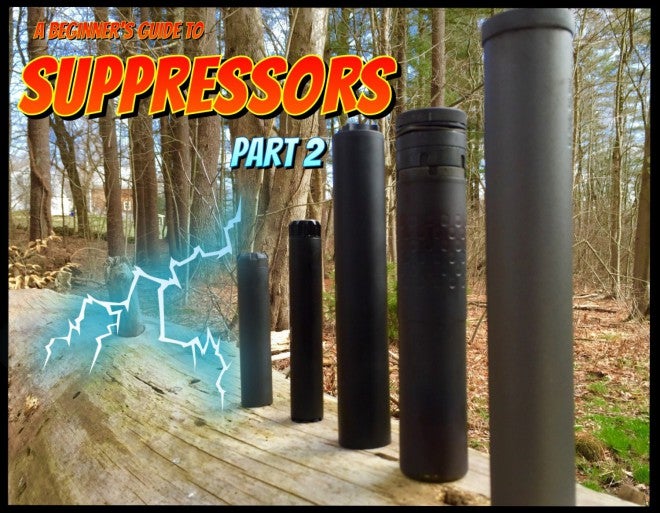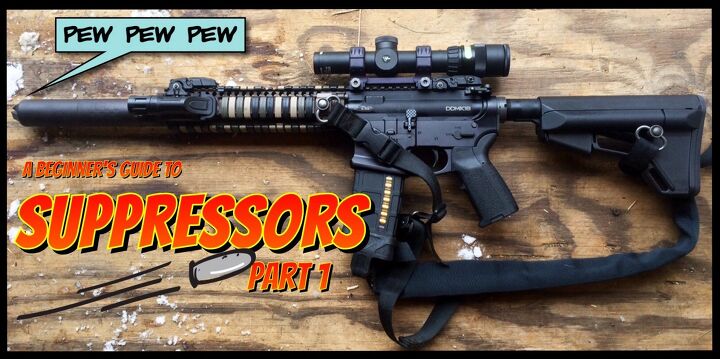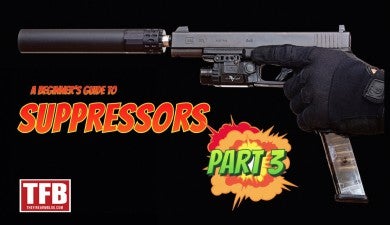So, you have always wanted a suppressor but figured that they were too expensive or the paperwork wasn’t worth your time. Or, you never considered owning a silencer until your idiot brother-in-law spun that monster brake/compensator on his AR at the range last week. Fear not, we are going to hold your hand through the process of researching, buying and owning suppressors. It really is pretty simple.
We left off at the end of Part 1 with a little research project: to review the offerings by the main suppressor manufacturers and find a silencer that fits most of your criteria. I’ll say ‘most’ since nothing is going to be perfect and you will end up making concessions no matter what you finally decide to buy. (I mentioned that you would end up owning more than one can anyway, right?). Hopefully you looked at all the specifications and mounting options to pick two or three solid candidates for your first silencer.
Part 2
- Purchasing
- ATF Forms
- What To Do While you Wait
Purchasing
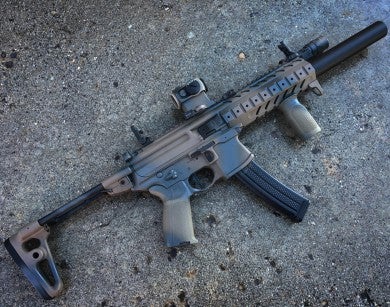
Photo courtesy of TwoSierra
When buying a new gun, you are left with two purchase options: your local gun store and online retailers. Strangely enough, buying a suppressor isn’t much different. If you remember from last time, Federal Firearms License (FFL) holders can opt to pay a yearly Special Occupational Tax (SOT – pronounced “S-O-T”) that allows them to sell National Firearms Act (NFA) controlled items. Chances are, your regular gun shop is also an SOT and is all ready to sell you a silencer.
If this is the case, the process of buying your new can might have just gotten easier. Roll down to the shop and ask what suppressor manufacturers they sell, what they have in stock and at what price. Hopefully all three of these criteria are met. Unfortunately, some gun shops, like any other business, may try to sell you something you don’t want or need. Remember, you researched you silencer choice thoroughly; don’t settle for something that won’t fit your needs. There’s a good chance your shop won’t have your model or even brand in stock, which means they will have to place an order for you.
Because the movement of NFA items is tightly regulated, silencers transfer between manufacturers and dealers (or dealers to other dealers) by a pre-approval process using Form 5320.3 (also known as a Form 3) from the Bureau of Alcohol Tobacco Firearms and Explosives (BATFE). If your dealer needs to order more suppressors, they will call up a manufacturer, distributor or another dealer and place an order. That company then needs to file a Form 3 for every NFA item that they are transferring to your dealer. And it has to be approved by the BATFE before they can ship anything out.
The Form 3 process is painfully archaic because dealers (and eventually you) can be forced to wait up to six weeks just to receive their BATFE approval to send and receive silencers. Form 3’s were being approved electronically for a brief time through the use of the BATFE’s EForm system, however technical issues caused by an influx of submissions forced some of the available services back to a paper format. Long story short, if your local dealer has to order your suppressor from another dealer, you will have to wait at least an extra month before you can start filling out your transfer paperwork. If you want to see what a Form 3 actually looks like, click here, but remember only dealers will see this paperwork.
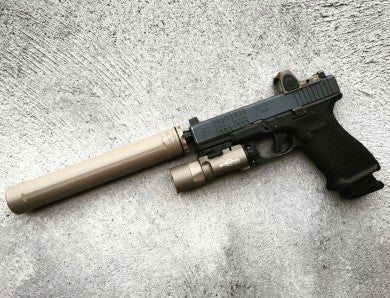
Photo courtesy of TwoSierra
So with the added wait, why would you not just buy something in stock? Sometimes your dealer has nothing you want in stock or the price is much higher than can be find on online retailers. I always lean to support my local dealer whenever possible, however sometimes it’s hard to pass up a good deal online. And many of the FFL/SOTs don’t have a storefront (sometimes referred to as ‘kitchen table FFLs’) and will not hold much of an inventory anyway. Much of these home-based FFL’s revenue comes from transfer fees. More on these added costs below.
After looking around the shops in your area and either finding nothing in stock or the prices at (or above) MSRP, you’ve decided to buy your first suppressor online. This sounds like it’s going to be a real pain in the neck. Actually, the process is almost as easy as buying a non-NFA firearm online. Once you find the suppressor you want, put in your billing and payment information, indicate your local FFL/SOT where the silencer will be transferred to and click submit. From here, the online retailer files that Form 3 with the BATFE and, once approved, ships your silencer to your local dealer. Except for the wait, the whole process is about as easy as buying your spouse an anniversary present on Amazon (make sure to get them something nice). One added benefit from buying online: depending on your state, you may save yourself any additional sales taxes.
Back to transfer fees: make sure to pick a local dealer and discuss any transfer fees and other information before you order online. Dealers can charge anywhere from $50 to $150 for the transfer of your suppressor, and if you are in the upper part of this range, it could negate any cost savings you made by buying online. Also, some dealers will discount transfer fees for multiple NFA items – another reason to buy multiple cans at once (as if you needed another reason). Besides, you wouldn’t buy a handgun online without first discussing the terms with your local dealer; it’s just common sense.
The last bit of advice on buying a silencer either locally or online is don’t wait. The longer you delay your purchase, the longer you wait to get your BATFE forms into the system and the longer it is going to take to get your toys.
Online Suppressor Retailers (In Alphabetical Order)
** I’ve also included the state of each company. If you are in the same state as one of these dealers, it may save you the additional wait of a Form 3 approval. **
Brownells – http://www.brownells.com/rifle-parts/muzzle-devices/suppressors/index.htm – IA
Bud’s Gun Shop – www.budsgunshop.com – KY
Capitol Armory – http://www.capitolarmory.com/ – TX
Dakota Silencer – http://www.dakotasilencer.com/ – MN, MT, NE, ND, SD, WY
DSG Arms – https://dsgarms.com/suppressors – TX
Gamaliel Shooting Supply – https://www.gamaliel.com/ – KY
Grab A Gun – http://grabagun.com/class-3.html – TX
Hansohn Brothers – http://hansohnbrothers.com/ – VA
Quiet Riot Firearms – http://www.quietriotfirearms.com/ – GA
Rainier Arms – https://www.rainierarms.com/complete-firearms-class-iii/nfa/silencers – WA
Silencer Loft – http://www.silencerloft.com – AL
SilencerHQ – http://www.silencerhq.com – NE
Silencer Shop – http://www.silencershop.com/ – TX
SilencersOnline – http://www.silencersonline.com/ – FL
Tar Heel State Firearms – http://www.tarheelstatefirearms.com/ – SC, NC
Obviously this isn’t a comprehensive list of every online dealer, so shop around. If you think I’ve forgotten a reputable dealer, make a note in the comments section.
ATF Forms
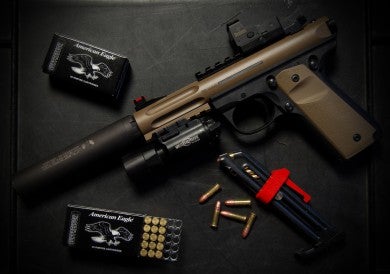
Photo courtesy of TwoSierra
So you just bought your first suppressor. Congratulations! But you are really only about halfway through the process.
Your first decision will be whether you are going to be transferring your new suppressor to an individual (yourself) or an entity (a trust or corporation with you as a trustee or officer). Here’s a brief breakdown of each option:
Individual – Historically the most common type of transfer (until recently), individual transfers require photographs and fingerprints of the transferee, a Chief Law Enforcement Officer (CLEO) sign-off and a background check conducted by the BATFE. Pros: There’s no trust or corporation paperwork to set up prior to transferring your silencer. Cons: It is only legal for you to possess your suppressor (you can’t loan it out to anyone).*
Entity – Transferring a silencer into a trust or corporation has the advantage of allowing other trustees/officers to use them without you being there because the entity owns them, not you individually. Also, under the current rules, transfers of NFA items to entities do not require fingerprints, photographs or CLEO sign-off, Be careful; while basic trust documents are easy to create and use, more complicated entity transfers can cause legal issues if not done correctly. Many retailers offer trust setup services for a fee, but as with any legal documentation, seeking competent legal council is always recommended.*
* If you remember from Part 1, the process for NFA transfers is set to change in July. Both individuals and entities will be required to submit photographs and fingerprints. Where as the CLEO requirement will become a only notification and not an authorization as it is now. Once the new rules are clarified and the paperwork is finalized, we will make sure to post an update to the process.
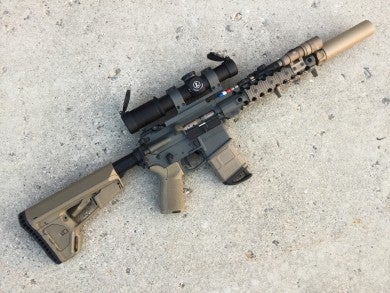
Photo courtesy of TwoSierra
Although the bulk of the transfer paperwork will be handled by your dealer, it’s important to know an understand what you are filling out and signing. I’ve added screen shots of the first three pages of the (current) Form 4, but it is your responsibility to read the additional three instruction pages and check for updated forms. You are investing your money and your time into this suppressor – make sure it’s done right.
“Go to an experienced dealer that handles all the paperwork for you – they should have also done a fair amount of Form 4s,” says Jeremy Mallette from Silencer Shop, an online silencer retailer and distributor based in Texas. “If an FFL won’t handle the paperwork for you then find another place. There are a lot of local FFLs that take good care of their customers, so seek them out.”
It is especially important to make sure the information on your Form 4 is complete and correct. Any errors could cause your transfer application to go in to problem status. More on checking the status of your submission and possible problems below. Also you will need two original and complete copies of your Form 4.
BATFE Form 4 (5320.4) – Page 1
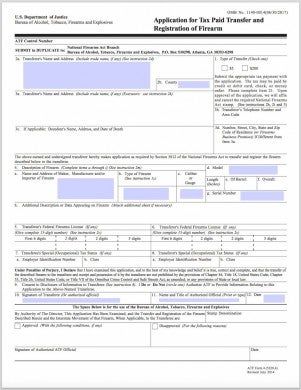
This page is pretty straight forward. Especially for your first purchase, your dealer should explain each of these fields and most good dealers will actually complete the first page of the Form 4. I’ve highlighted the important fields that your should check for accuracy with a blue box. Everything listed on the form needs to match your personal information or your entity’s information and your silencer’s information exactly or you risk delays in the transfer process.
- 2a. You (or your entity) are the transferee. This is for your name (or entity name) and address.
- 4a. The company name and address of your silencer.
- 4b. Silencer.
- 4c. Caliber or Gauge.
- 4d. Model name/number.
- 4f. Length of silencer.
- 4g. Serial Number.
- 10. Your dealer’s original signature in ink.
- 11. Your dealer’s printed name and title.
- 12. Date.
BATFE Form 4 (5320.4) – Page 2
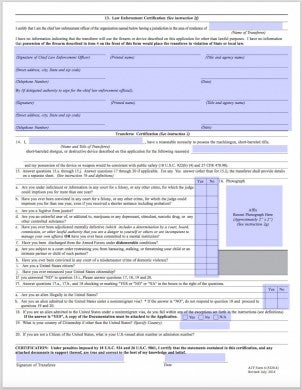
Entities: Skip this entire page. (Reminder: In July of 2016 there will be a new form where entities will also need to complete the background questions as well as include fingerprints and photographs with their application.)
Individuals:
- 13. Top line: Fill in your complete name. The rest is completed by your CLEO. Make sure all boxes are filled out completely before you leave their office.
- 14. (As per the instructions, not required for silencers.)
- 15a. through 15j. Answer truthfully. These questions should be familiar if you have ever bought a firearm from a dealer and undergone a National Instant Criminal Background (NICS) check.
- 16. Attach a passport photo here. There are plenty of Apps that will take passport-sized photos. Make sure to print them on photo paper. Or get your photos professionally taken at a store like CVS or Rite-Aid.
- 17. through 20. Citizenship and Immigration questions. Complete only if you answered ‘no’ to question 15i. – ‘Are you a United States citizen?’
- CERTIFICATION: Sign and date
A quick word about the CLEO certification: Be professional and polite and it’s always a good idea to call ahead and make an appointment before you head down to the station for your signature. It also doesn’t hurt to ask your dealer if they know which CLEO for your area is NFA friendly. You’ll be less likely to waste time if you know going in whether or not a particular agency head will sign your forms. Don’t forget to get both copies of your Form 4 signed.
Again, in July of 2016 this process changes from a CLEO sign-off to only a CLEO notification.
You will also need to find a place to get your fingerprints taken – most police departments will take your fingerprints on the blue-lined FD-258 “applicant” cards for a small fee. When you call to setup your CLEO sign-off appointment, ask about getting printed and to make sure they have the blue fingerprint cards available. With the coming changes, many dealers are preparing to take fingerprints in-house which will save you additional time and hassle.
BATFE Form 4 (5320.4) – Page 3
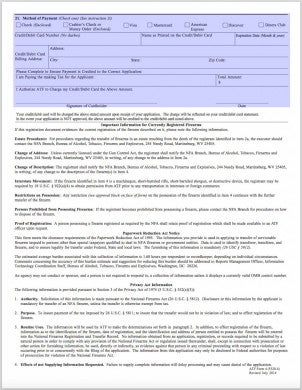
- 21. Payment: Make a $200 payment to the ‘BATFE – National Firearms Act Branch’.
Proofread and sign everything before you get ready to ship off your application packet. Make a copy of your forms or at least take a picture – it’s always great idea to have all the information from your Form 4 on file, just in case. If for some reason you forget, don’t worry, your dealer also has copies of your forms.
Collate all your documents into two copies:
- Two (2) original copies of your completed Form 4.
- Two (2) completed fingerprint cards – Individual Only
- Two (2) passport photos – Individual Only
- Two (2) copies of you Trust or incorporation documents – Entity only*
- Payment (either check, money order, cashiers check or credit/debit card information)
* In reality, I believe only one copy of your entity paperwork is required, but I like to submit two complete packets, just in case.
Mail your for forms (at a minimum using USPS* Priority with tracking) to:
National Firearms Act Branch, Bureau of Alcohol, Tobacco, Firearms and Explosives, P.O. Box 530298, Atlanta, GA 30353-0298
* UPS and FedEx won’t ship to PO Boxes.
So, with all these changes to the process coming, why not just wait until July to buy your first suppressor? For one thing, the wait for the application process only gets longer every day you don’t submit your forms. “At this time the wait for Form 4’s to get approved is about six months,” says Jeremy from Silencer Shop. “And we could soon be looking at 12 months. I always say the best time to buy is always ‘right now’.”
What To Do While You Wait
You can call the BATFE NFA Branch (304-616-4500) to check the status of your Form 4 – just have your entity name (or just your name) and your silencer’s serial number handy. The most information they will be able to give you is that your paperwork ‘In Process’ or in ‘Problem Status’. If it is the latter, don’t worry, your dealer will handle most the issues in the unlikely event your Form 4 goes into this dreaded category. The most likely culprit is a spelling or punctuation issue (yes, the BATFE is that exact). Even if your form has a problem, it will only slow your approval by a week or two – not a big deal in the grand scheme of things.
All that being said, I have never called the BATFE to have them check on my submission, and I suggest you don’t either. If you must, call once, about a month after you send your forms to make sure everything was received properly. Then just wait. Calling once a week doesn’t help you or anyone else get a faster approval.
One alternative is to use NFATracker.com. This site is a kind of ‘crowd-sourcing’ for NFA applicants – each user inputs there milestone dates in the BATFE process and NFATracker estimates your timeline based on everyone else in the country. It’s not perfect (the tracker relies solely on unofficial user inputted data) but it is a useful tool that i have used with success for every submission.
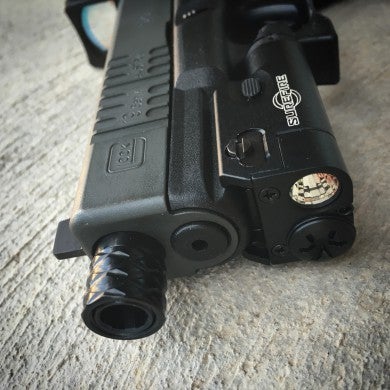
Photo courtesy of TwoSierra
Barrel Threading –
Hopefully you spent enough time researching your hosts to determine your barrel threading options. For rifles like AR-15s, most barrels are already threaded with a standard thread pitch that is ‘concentric to the bore’ (meaning the threads are exact enough to mount a silencer without worrying about damage). Other guns like AK-47 patterned rifles may have threaded barrels, but the threads may not be suitable for mounting a suppressor. There are tools you can use to check to see if the threads are concentric, but when in doubt, have a solid gunsmith confirm your barrel’s threading.
Speaking of gunsmiths, if you need to have your barrel threaded, take a look at options online. ADCO Firearms and Class 3 Machining are two respected names in the business, but there are plenty of others out there. There’s a chance that you have a good local gunsmith that can thread your barrel without you having to ship it out of state.
In the end, sometimes it’s easier and cheaper to buy a new barrel with high-quality threads. This is especially true with pistol hosts. The market for threaded pistol barrels is hot: match grade options from KKM Precision is at the upper end of the quality (and pricing) scale, whereas the offerings from Lone Wolf Distributors are slightly more affordable. SilencerCo, Gemtech and Surefire are all silencer manufacturers that also sell their own line of threaded barrels. Just make sure the barrel is right for your gun and has the correct thread pitch.
Muzzle Devices –
Most quick disconnect (QD) rifle cans will include either a flash hider or brake that is specific to your mounting system. Personally, I detest brakes and when given the choice, I will pick a flash hider every time. But, if you plan on always shooting that particular rifle suppressed, there is evidence (albeit non-scientific) that using a brake can reduce wear on your can’s internals.
In any case, you are probably going to want a few more muzzle devices (*cough* flash hider *cough*) so you can shoot your otter rifles suppressed. Now is a good time to shop around.
Boosters, Pistons or Nielsen Devices –
Flashing back to Part 1 in our series, if you bought a pistol silencer, you are most likely going to need a booster (aka piston) for mounting on to your gun. The booster uses inertia from a spring to assist the recoil operation of a pistol and ensures proper cycling. Most pistol silencers include one piston, but you may want to buy others for additional hosts. Hopefully you planned ahead: whereas a .45ACP silencer will probably work on a 9mm host, the reverse is definitely not true.
The biggest consideration is matching the thread pitch on your barrel with the thread pitch in your piston – be diligent when shopping to make sure you get the right setup.
Let’s wrap up Part 2 with another homework project: Thread, mount and booster your host(s). Also, repeat Part 1 and start looking for your second can. You might as well start now.
I always say the best time to buy is always ‘right now’ – Jeremy Mallette, Silencer Shop
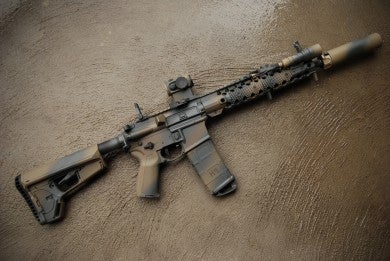
Photo courtesy of TwoSierra
Quick Review
- Decide if you are buying locally or online.
- Buy your silencer.
- Complete and proofread your Form 4.
- Send your forms, paperwork and payment in to the BATFE.
- Thread barrels and buy muzzle devices.
See you for Part 3 of A Beginners Guide to Suppressors.
 Your Privacy Choices
Your Privacy Choices
